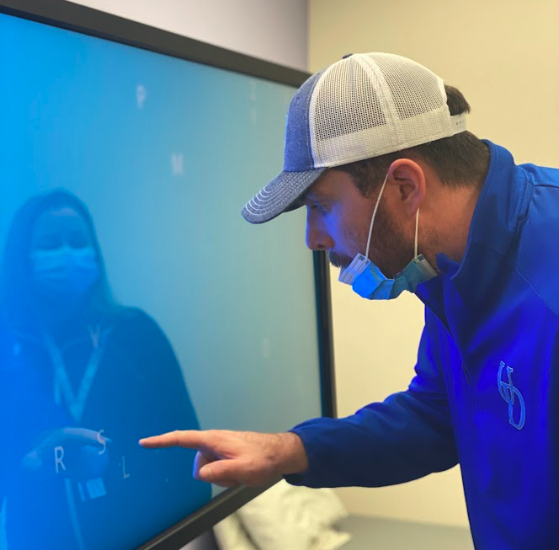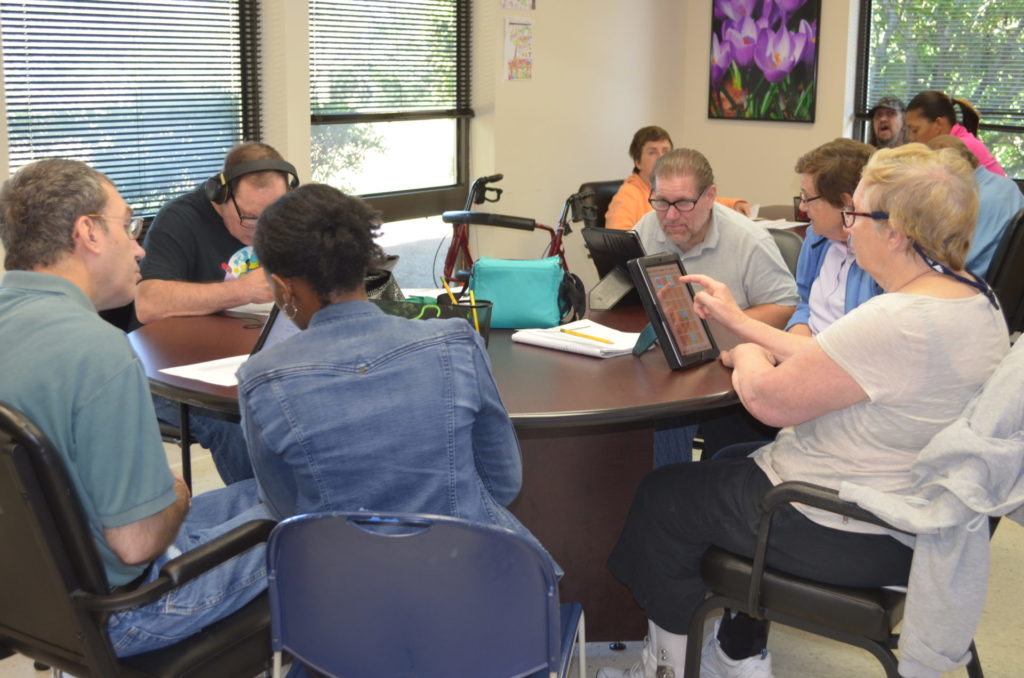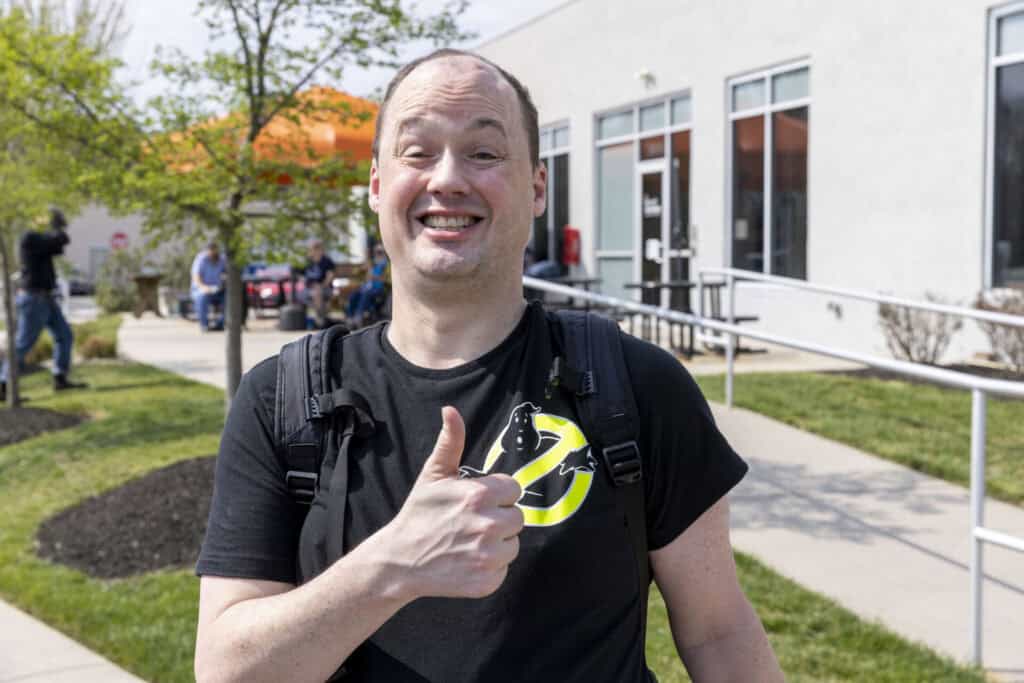Recovery doesn’t stop when formal therapy ends. In many ways, that’s when meaningful purpose begins. In this guide, Bancroft NeuroRehab Rehabilitation Supervisor Nicole Schwartz, OTR/L, OTD, CBIS, shares practical, accessible ways to continue therapy at home. From everyday tasks to simple exercises, these tips can help you build stregnth, regain independence, and make continued progress part of your daily routine.
Simple, Practical Exercises You Can Do at Home
You don’t need a gym to make gains. With consistency and creativity, your everyday environment can support meaningful recovery.
- Walking is one of the most beneficial post-stroke exercises. Whether it’s around the house, your neighborhood, or a local park, walking improves strength, endurance, and gait — and it’s easy to do with loved ones.
- Sit-to-stands — moving from a seated position to standing and back again — help strengthen your lower body and improve transitions. To increase difficulty, try adding light weights or adjusting your speed.
- For the upper body, repetition is key. Engaging your affected arm and hand in daily tasks, like transferring socks, utensils, or small toys from one spot to another, promotes neuroplasticity, the brain’s ability to form new connections. Varying object size and texture adds helpful sensory feedback.
- Your daily activities can be powerful therapy, too.
- Use your affected hand to lift the coffee pot lid, place a K-Cup, or load the dishwasher.
- Try folding laundry while standing to engage your lower body.
- Hold, smooth, or manipulate fabric with your affected hand; even small movements matter.
- Use your affected hand to lift the coffee pot lid, place a K-Cup, or load the dishwasher.
- Don’t forget the home exercise program (HEP) your therapist gave you. Many programs now include apps with video demonstrations to help you stay on track after discharge.
Remember: consistency and safety are key to effective home exercise therapy. Try doing your exercises in front of a mirror to check your alignment and form. Choose positions where you feel secure, such as sitting or lying down, and save more challenging exercises for when someone is nearby to help.
Many people wonder how long they should exercise each day. While this varies from person to person, and you should always check with your therapist, a good rule of thumb is to aim for about an hour of focused exercise daily. If that feels like too much at once, break it into two, three, or even four shorter sessions throughout the day.
Making It Enjoyable: The Key to Sticking with Therapy
One of the most important parts of staying consistent with your home exercise routine is making it something you actually enjoy. If therapy feels like a chore, it’s much harder to stay motivated — but when you find ways to make it fun, it becomes something you’ll look forward to.
- Reframe your mindset: You “get to” exercise to get stronger, not because you “have to.”
- Choose settings that make you feel good, like being outside on a nice day.
- Turn on your favorite music to boost your energy.
- Invite a friend or family member to join you or simply keep you company.
- To stay motivated, set small, achievable goals, like walking a little farther, doing one more rep, or standing a little longer than you did yesterday.
Add a little fun — get creative!
- Make a game out of your progress by setting weekly challenges to increase steps, reps, or resistance.
- Start friendly competitions with loved ones to keep things lighthearted and engaging.
- Use common household items like spice jars, water bottles, toys for grasping, lifting, or transferring exercises.
- If it’s safe, even stairs can become a great tool to build strength and endurance.
- Reward yourself for meeting goals, whether it’s a favorite snack, a short rest in the sun, a new pair of shoes, or simply checking off your progress on a chart.
Enjoyment isn’t just a bonus; it’s essential. The more positive your experience, the more likely you are to stick with your routine and keep making progress. Make therapy your own, and celebrate every step forward.
Keep Going: Progress Takes Time and It's Always Possible
Recovery doesn’t stop when therapy sessions end. In fact, your brain continues to adapt and heal long after a stroke through a process called neuroplasticity, its ability to form new connections over time. That means real progress is possible months, even years, into your recovery. It may happen more slowly, but every step forward counts.
Consistency matters, yes, but the rest is equally important. Sleep plays a critical role in healing, energy, and mood. If you’re experiencing poor sleep, give yourself time to reset. Taking a day to recharge isn’t a setback; it’s part of taking care of your whole self.
Remember: be patient. Stroke recovery is a journey, not a race. Some days will feel easier than others, and that’s okay. Celebrate every win, no matter how small, and when others notice your progress, let that remind you how far you’ve come.
And above all, keep moving forward, one day at a time.
Additional Resources
How to Support a Stroke Survivor: A Guide for Family and Friends
Recognizing and Treating the Psychological Effects of Stroke
The Role of Rehabilitation in Stroke Recovery
Caring for the Caregiver: Healing Potential of Psychotherapy
ABOUT THE EXPERT


Nicole Schwartz is a licensed and NBCOT registered occupational therapist and Rehabilitation Supervisor at Bancroft NeuroRehab in Toms River, holding certifications as a Brain Injury Specialist and in LSVT BIG for Parkinson’s. With degrees in Psychology and Occupational Therapy from Misericordia University, her diverse experience spans various rehabilitation settings, and she is passionate about the challenges and treatment opportunities in neurological injury care.












